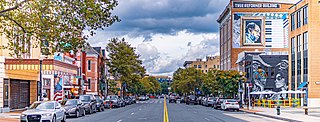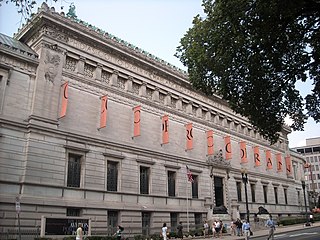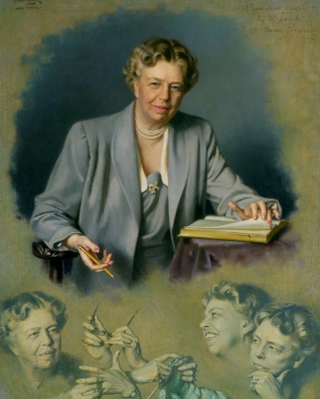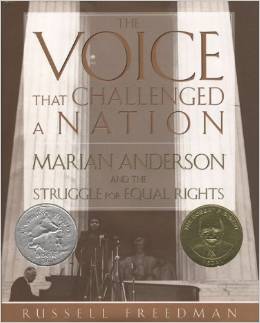Marian Anderson: The Lincoln Memorial Concert is a 1939 documentary film that documents a concert performance by African American opera singer Marian Anderson after the Daughters of the American Revolution (DAR) had her barred from singing in Washington D.C.'s Constitution Hall because she was Black. Officials of the District of Columbia also barred her from performing in the auditorium of a white public high school. First Lady Eleanor Roosevelt helped hold the concert at Lincoln Memorial, on federal property. The performance on Easter Sunday, April 9, 1939, was attended by 75,000. In 2001, this documentary film was selected for preservation in the National Film Registry by the Library of Congress.

Marian Anderson was an American contralto. She performed a wide range of music, from opera to spirituals. Anderson performed with renowned orchestras in major concert and recital venues throughout the United States and Europe between 1925 and 1965.

The National Mall is a landscaped park near the downtown area of Washington, D.C., the capital city of the United States. It contains and borders a number of museums of the Smithsonian Institution, art galleries, cultural institutions, and various memorials, sculptures, and statues. It is administered by the National Park Service (NPS) of the United States Department of the Interior as part of the National Mall and Memorial Parks unit of the National Park System. The park receives approximately 24 million visitors each year.

The National Society Daughters of the American Revolution is a lineage-based membership service organization for women who are directly descended from a person involved in the United States' struggle for independence. A non-profit group, they promote education and patriotism. The organization's membership is limited to direct lineal descendants of soldiers or others of the Revolutionary period who aided the cause of independence; applicants must have reached 18 years of age and are reviewed at the chapter level for admission. The DAR has over 185,000 current members in the United States and other countries. Its motto is "God, Home, and Country".

Washington, D.C., has been home to many prominent musicians and is particularly known for the musical genres of Jazz, Rhythm & Blues, bluegrass, punk rock and its locally-developed descendants hardcore and emo, and a local funk genre called go-go. The first major musical figure from District of Columbia was John Philip Sousa, a military brass band composer. Later figures include jazz musicians, such as Duke Ellington, Charlie Rouse, Buck Hill, Ron Holloway, Davey Yarborough, Michael A. Thomas, Butch Warren, and DeAndrey Howard; soul musicians, including Billy Stewart, The Unifics, The Moments, Ray, Goodman & Brown, Van McCoy, The Presidents, The Choice Four, Vernon Burch, guitarist Charles Pitts, and Sir Joe Quarterman & Free Soul.

Foggy Bottom is a neighborhood of Washington, D.C., located in Northwest D.C. Stretching west of the White House towards the Potomac River, the neighborhood is home to numerous federal agencies and international institutions, while the core of the neighborhood is occupied by George Washington University.

There are many outdoor sculptures in Washington, D.C. In addition to the capital's most famous monuments and memorials, many figures recognized as national heroes have been posthumously awarded with his or her own statue in a park or public square. Some figures appear on several statues: Abraham Lincoln, for example, has at least three likenesses, including those at the Lincoln Memorial, in Lincoln Park, and the old Superior Court of the District of Columbia. A number of international figures, such as Mohandas Gandhi, have also been immortalized with statues. The Statue of Freedom is a 19½-foot tall allegorical statue that rests atop the United States Capitol dome.

Waddy Butler Wood was a prominent American architect of the early 20th century and resident of Washington, D.C. Although Wood designed and remodeled numerous private residences, his reputation rested primarily on his larger commissions, such as banks, commercial offices, and government buildings. His most famous works include the Woodrow Wilson House and the Main Interior Building.

The Memorial Continental Hall in Washington, D.C. is the national headquarters of the Daughters of the American Revolution (DAR). It is located at 1776 D Street NW, sharing a city block with the DAR's later-built Administration Building, and Constitution Hall. Completed in 1910, it is the oldest of the three buildings. It was the site of the 1922 Washington Naval Conference, a major diplomatic event in the aftermath of World War I. The building was declared a National Historic Landmark in 1972.

My Day was a newspaper column written by First Lady of the United States Eleanor Roosevelt (ER) six days a week from December 31, 1935, to September 26, 1962. In her column, Roosevelt discussed issues including civil rights, women's rights, and various current events. This column allowed ER to spread her ideas, thoughts, and perspectives on contemporary events to the American public through local newspapers. Through My Day, Roosevelt became the first First Lady to write a daily newspaper column. Roosevelt also wrote for Ladies Home Journal, McCall's, and published various articles in Vogue and other women's magazines.

The Pacific Rim Tour was a concert tour of arenas and stadiums by American Pop/R&B singer Whitney Houston. The tour included 10 concert dates in Japan, Taiwan, Thailand, Australia and United States in 1997. The tour was in support of her 1996 multi-platinum album, The Preacher's Wife.
Classic Whitney: Live from Washington, D.C., were live concerts by Whitney Houston.

The Main Interior Building, officially known as the Stewart Lee Udall Department of the Interior Building, located in Washington, D.C., is the headquarters of the United States Department of the Interior.

The Andrew W. Mellon Auditorium is a 750-seat historic Neoclassical auditorium located at 1301 Constitution Avenue NW in Washington, D.C. The auditorium, which connects two wings of the William Jefferson Clinton Federal Building, is owned by the U.S. government but available for use by the public.

Lisner Auditorium is a performance venue sited on the Foggy Bottom campus of George Washington University at 730 21st Street Northwest, Washington, D.C. Named for Abram Lisner (1852-1938), a university trustee and benefactor whose will provided one million dollars towards its construction, it was designed in 1940 and completed in 1946. Constructed in the stripped classicist style of the late Art Deco and host to major classical, folk, rock, blues, opera, and theatrical performances over the decades, it was placed on the National Register of Historic Places in 1990 for its dual significance as an architectural work and as a performance venue.

The Pan American Union Building is the headquarters for the Organization of American States. It is located at 17th Street N.W. between C Street N.W. and Constitution Avenue, Northwest, Washington, D.C.

The Voice That Challenged a Nation: Marian Anderson and the Struggle for Equal Rights is a 2004 children's nonfiction book by Russell Freedman. It received both a Sibert Medal and a Newbery Honor Book award in 2005. The book tells the story of Marian Anderson, an African-American contralto, who during her journey to establishing a singing career, inadvertently became an activist for civil and political rights.

Eric Gugler was an American Neoclassical architect, interior designer, sculptor and muralist. He was selected by President Franklin D. Roosevelt to design the Oval Office.

Sarah Emily Corbin Robert served as the 17th President General of the Daughters of the American Revolution and was a noted authority on parliamentary procedure.























